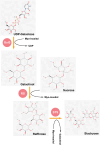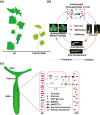Significance of Raffinose Family Oligosaccharides (RFOs) metabolism in plants
- PMID: 39883346
- PMCID: PMC11740855
- DOI: 10.1007/s44307-024-00022-y
Significance of Raffinose Family Oligosaccharides (RFOs) metabolism in plants
Abstract
Raffinose Family Oligosaccharides (RFOs) are a kind of polysaccharide containing D-galactose, and they widely exist in higher plants. Synthesis of RFOs begins with galactinol synthase (GolS; EC 2.4.1.123) to convert myo-inositol into galactinol. The subsequent formation of raffinose and stachyose are catalyzed by raffinose synthase (RS; EC 2.4.1.82) and stachyose synthase (STS; EC 2.4.1.67) using sucrose and galactinol as substrate, respectively. The hydrolysis of RFOs is finished by α-galactosidase (α-Gal; EC 3.2.1.22) to produce sucrose and galactose. Importance of RFOs metabolism have been summarized, e.g. In RFOs translocating plants, the phloem loading and unloading of RFOs are widely reported in mediating the plant development process. Interference function of RFOs synthesis or hydrolysis enzymes caused growth defect. In addition, the metabolism of RFOs involved in the biotic or abiotic stresses was discussed in this review. Overall, this literature summarizes our current understanding of RFOs metabolism and points out knowledge gaps that need to be filled in future.
Keywords: Galactinol synthase; RFOs; Raffinose synthase; Stachyose synthase; Stress; α-Galactosidase.
© 2024. The Author(s).
Conflict of interest statement
Declarations. Ethics approval and consent to participate: All analyses were performed under laboratory conditions. Consent for publication: The authors declare that they agreed with the content and that all gave explicit consent to submit and that they obtained consent from the responsible authorities at the institute where the work has been carried out, before the work is submitted. Competing interests: The authors declare that they have no known competing financial interests or personal relationships that could have appeared to influence the work reported in this paper.
Figures



Similar articles
-
Significance of galactinol and raffinose family oligosaccharide synthesis in plants.Front Plant Sci. 2015 Aug 26;6:656. doi: 10.3389/fpls.2015.00656. eCollection 2015. Front Plant Sci. 2015. PMID: 26379684 Free PMC article. Review.
-
Physiological aspects of raffinose family oligosaccharides in plants: protection against abiotic stress.Plant Biol (Stuttg). 2014 Jan;16(1):1-8. doi: 10.1111/plb.12053. Epub 2013 Aug 12. Plant Biol (Stuttg). 2014. PMID: 23937337 Review.
-
Regulation of Seed Vigor by Manipulation of Raffinose Family Oligosaccharides in Maize and Arabidopsis thaliana.Mol Plant. 2017 Dec 4;10(12):1540-1555. doi: 10.1016/j.molp.2017.10.014. Epub 2017 Nov 7. Mol Plant. 2017. PMID: 29122666
-
myo-Inositol and sucrose concentrations affect the accumulation of raffinose family oligosaccharides in seeds.J Exp Bot. 2004 Sep;55(405):1981-7. doi: 10.1093/jxb/erh216. Epub 2004 Jul 30. J Exp Bot. 2004. PMID: 15286144
-
Sugar metabolism in the desiccation tolerant grass Oropetium thomaeum in response to environmental stresses.Plant Sci. 2018 May;270:30-36. doi: 10.1016/j.plantsci.2018.02.004. Epub 2018 Feb 8. Plant Sci. 2018. PMID: 29576083
Cited by
-
Raffinose family oligosaccharide hydrolysis by alkaline α-galactosidase CsAGA2 controls seed development in cucumber.Plant Cell. 2025 May 9;37(5):koaf061. doi: 10.1093/plcell/koaf061. Plant Cell. 2025. PMID: 40123513
-
Silencing of the Alkaline α-Galactosidase Gene CsAGA1 Impairs Root and Gall Development in Cucumber upon Meloidogyne incognita Infection.Int J Mol Sci. 2025 Jul 11;26(14):6686. doi: 10.3390/ijms26146686. Int J Mol Sci. 2025. PMID: 40724936 Free PMC article.
References
-
- Abelenda JA, Bergonzi S, Oortwijn M, Sonnewald S, Du M, Visser RGF, Sonnewald U, Bachem CWB. Source-sink regulation is mediated by interaction of an FT Homolog with a SWEET protein in potato. Curr Biol. 2019;29(1178–1186):e1176. - PubMed
-
- Bartels D, Sunkar R. Drought and salt tolerance in plants. Crit Rev Plant Sci. 2005;24:23–58.
-
- Beebe DU, Turgeon R. Localization of galactinol, raffinose, and stachyose synthesis in Cucurbita pepo leaves. Planta. 1992;188:354–61. - PubMed
-
- Blöchl A, March GG-d, Sourdioux M, Peterbauer T, Richter A. Induction of raffinose oligosaccharide biosynthesis by abscisic acid in somatic embryos of alfalfa (Medicago sativa L.). Plant Sci. 2005;168:1075–82.
-
- Braun DM, Wang L, Ruan YL. Understanding and manipulating sucrose phloem loading, unloading, metabolism, and signalling to enhance crop yield and food security. J Exp Bot. 2014;65:1713–35. - PubMed
Publication types
Grants and funding
LinkOut - more resources
Full Text Sources
